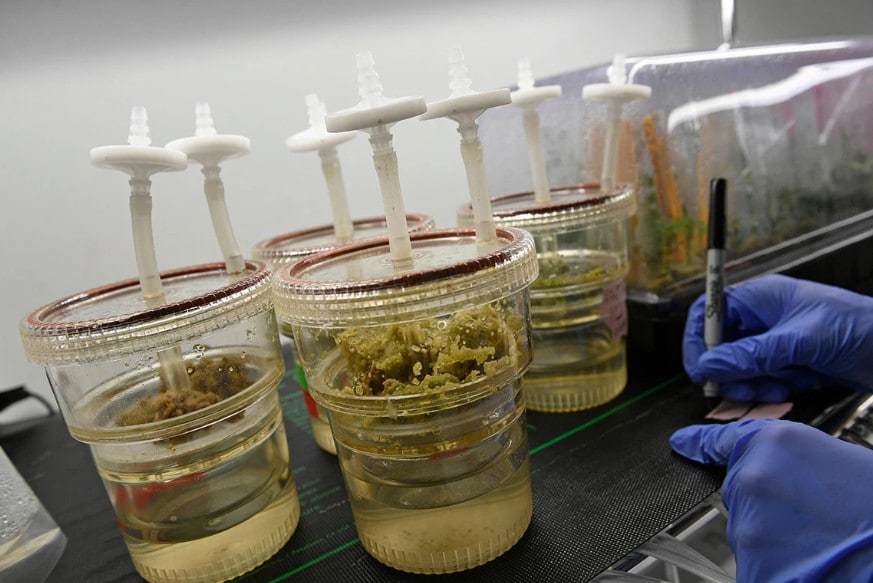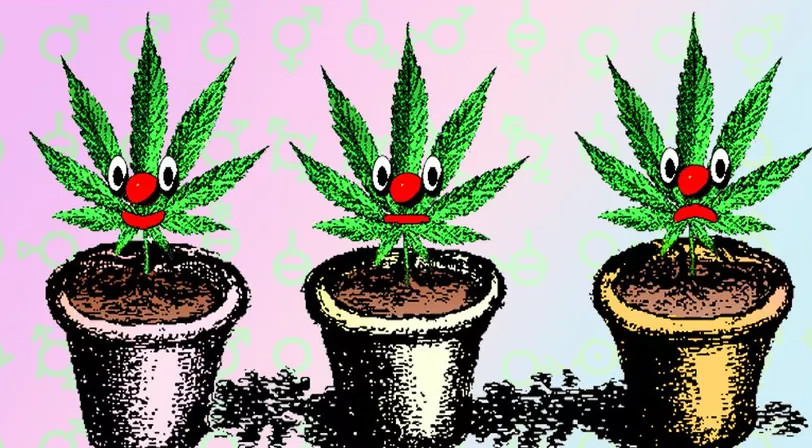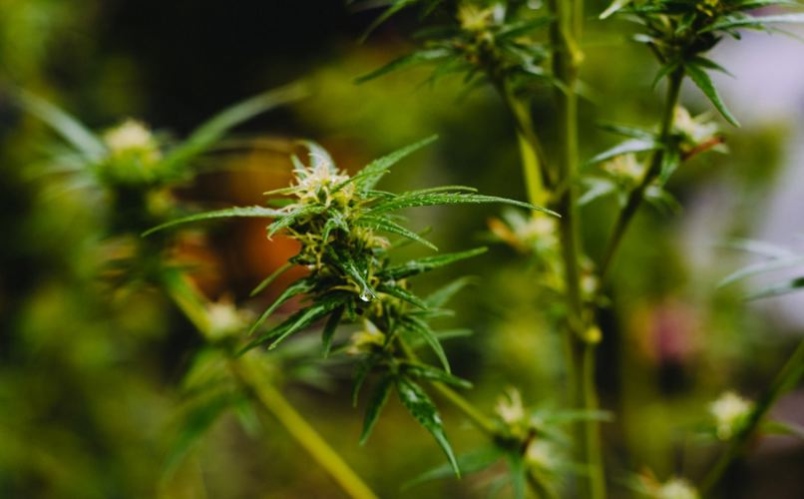When you think of weed, you likely think of a sticky bud, an oil, maybe even a tincture. But what if you reconfigured your notion of cannabis to instead envision an abstract scientific equation? Sure, this may sound like the stuff of stoner sci-fi, except that it’s the real-life direction that the cannabis industry is headed.
That’s because the future of weed is in formulations.
So while there will always be a need for skilled cultivators to grow the plant, consumers — especially novice consumers — more and more will veer toward a manufactured cannabis oil, edibles, pills, or tinctures, designed by scientists to target the consumer’s specific needs. The basis of these products are specially curated chemical concoctions, donning specific ratios of cannabinoids (like THC and CBD) and terpenes, aromatic compounds that provide a distinct character to each of marijuana’s varied psychoactive effects.
As adult-use and medical-marijuana policies become more commonplace, the canna-curious demographic is growing. Whether these naive consumers are interested in cannabis for its therapeutic or recreational benefits, many are not up for the gamble of smoking flower to see what happens. Rather, the new cannabis consumer is looking for an exact, consistent experience to reliably target either a particular medical ailment, or to bring about a specific, desired effect. And it turns out, these consistent, tailored experiences, as well as the technology used to procure them, comprise a company’s intellectual property — which can be transferred, legally, anywhere in the country. After all, we’re not talking about actual weed here, just its abstract scientific expression and methodology.
Some companies are turning that into a growing business. Innovative research and development companies with clinical labs are experimenting with plant genetics and chromatography, using a process of trial and error to see how different cannabinoids and terpenes uniquely interact with the human body. Ebbu and LucidMood, for example, both out of Colorado, are working on ways to customize the user experience, even to customize the cannabis plant itself, in order to emphasize a particular set of compounds.
“You can get something along the lines of a designer high,” says Tristan Watkins, chief science officer of LucidMood, which curates cannabinoid and terpene ratios to foster different moods for a line of vape pens (“party,” “bliss,” “relax,” “focus,” and “sleep” just to name a few). “We wanted to build additional formulations to help highlight or amplify the positive effect that people were looking for out of cannabis, while also mitigating the antithesis [of that effect],” he says.
Manipulating the ratios of these compounds will be what brings cannabis to the mainstream, he says. “With this formulated cannabis you have a lot more control over how you feel and maintaining consistency in the product, regardless of what state it was created in.” And that curated cannabis product will be the same six months later, or whenever you next try it. “It removes a lot of concern and perceived risk for the consumer,” Watkins adds.
To draft a formulation, scientists must first deconstruct the cannabis plant down to its individual compounds. Then, they can study the effects of those compounds, in isolation.
To understand, for instance, the extent to which the terpene linalool causes drowsiness, scientists would first look at how a particular ratio of THC and CBD alone impacts energy, and then what happens when a certain amount of linalool is added to that ratio. “We build up a step-by-step process until we find that our formulation was efficacious,” Watkins explains.
While THC and CBD are the most well-known cannabinoids, the cannabis plant contains dozens of active compounds — meaning that lesser known cannabinoids like CBN or CNG, for instance, as well as various terpenes, have yet to grab the spotlight. However, by isolating these compounds, scientists can better understand how they work and how to use them in context.
“There’s no way to make a true mainstream unless you can deliver on the concept of trust,” says Jon Cooper, founder and former CEO of Ebbu, now vice president of business development for Canopy, which acquired Ebbu for $4 million in October. “When we looked at this plant, we quickly started realizing that this thing is chemical chaos.” That’s what led Cooper and his colleagues to break down the cannabis plant and put those isolated compounds back together into specific combinations for a consistent experience.
Founded in 2013, Ebbu built a discovery lab for cannabinoids. There, scientists started to grow live human receptors to understand, in real time, how they would interact with those compound isolates.
However, beyond constructing novel cannabinoid/terpene combinations, Ebbu has gone one step further to “genetically edit” the plant so that it produces greater or lesser volumes of specific compounds. In doing so, scientists can create larger amounts of those compounds in a way that makes them commercially viable, Cooper explains. (Genetic editing, he points out, is different from genetic modification in that the latter introduces DNA, chromosomes, or some other foreign entity, such as a pesticide, into the plant, while the former works with the material that’s already, inherently there.)
“That’s something we can replicate worldwide,” he says.”The goal here was twofold: How do we create the best, most enjoyable recreational products, but how do we utilize these cannabinoids to create the most efficaciou medicine that I truly believe has the opportunity for changing the lives for hundreds of millions of people?”
But moreover, he says, this form of cannabis medicine has the added bonus of not feeling like actual medication. “Wouldn’t it be great if they could drink a tea, versus popping a pill?” Cooper says. “In the next ten years, smokeable flower form will be less than 10 percent of what’s consumed in the marketplace — people won’t think of [cannabis] as a stoner thing anymore.”
What’s more, by conceiving of cannabis via scientific equations or as novel (read: edited) plant varieties, companies can license their IP anywhere in the world — legally.
Those executing cannabis R&D have the option to retain their IP as trade secret, or to partner with a cultivation company in any state in order to share their own proprietary cannabinoid/terpene ratios or technology — like that behind Ebbu’s genetic editing technique — to co-create weed-based, designer products.
“Under patent law, there’s no prohibition on patenting cannabis related technology,” says Alison Malsbury, a San Francisco-based intellectual property attorney with cannabis law firm Harris Bricken. “For that reason, there’s no problem with patenting formulations of cannabis compounds so long as they meet other requirements for patentability.”
To get a patent, the invention must be novel, as well as non-obvious, and cannot already exist in nature. A wild strain of cannabis, for instance, could not be patented because the genetics weren’t manipulated or human-bred. But for proprietary blends or genetic editing technology, the incentive to patent would be to gain a limited monopoly (which lasts only a couple decades), so that the party seeking the patent is the only one who can make or sell the product, or license other people to do so.
“The thing that operators need to be aware of is if they transfer ownership of the patented technology to another company, how that company made use of that technology would be dictated by state law,” says Malsbury. “You can patent cannabis-related technology all day long and not violate federal law, but where federal law comes into play is where you are actually using that patented technology.” In California, only license-holders can participate (and collaborate with other license-holders) in the state’s regulated system.
Another thing to beware of are patent trolls, she adds, companies that buy up patented technology in a variety of industries, but never use that technology — rather, they just use their patent rights to prevent other people from using that technology and to extort licensing fees.
Even so, these artificial preparations of cannabis compounds are different, namely because whoever made the artifice is likely the sole party to come up with that specific combination. “Formulations are going to be one of the best routes to actually obtaining patent protection and that’s what’s appealing to pharmaceutical companies,” Malsbury says. “As we see them starting to take interest in cannabis, I think formulations will be one of the means by which they stake their claims in the market.”
There’s also something called a method patent, which makes proprietary the way something is made (assuming it’s a new method). “We’re seeing more people patenting the strains and formulations, as well as the methods of making these formulations,” says IP attorney John Mansfield, owner of Portland, Oregon’s Mansfield Law. With plenty of controversy around patent infringement lawsuits, Mansfield asks “whether we should be patenting cannabis at all.”
While the option of patenting sellable technology beckons pharmaceutical companies into the cannabis industry, it may also offer protections to more boutique companies perfecting their plant varieties or crafting new products. At the same time, this technology can help cannabis brands appeal to the masses — from cannabis connoisseurs to newbies. It’s hard to fathom anyone would mind having a clearer idea of what to expect from their weed.
“With formulated cannabis products, you can get specific effects and all that but you can also tightly control how strong the high is, as well,” says Watkins. “By creating products that are mild in their dosing and the high they deliver, new users have a bit of a stepping stone and training wheels in the initial cannabis experience.” And for veteran stoners, all the more power to them to experiment with and understand these new cannabis highs.
Credit: rollingstone.com













